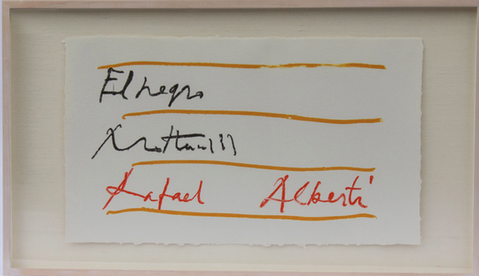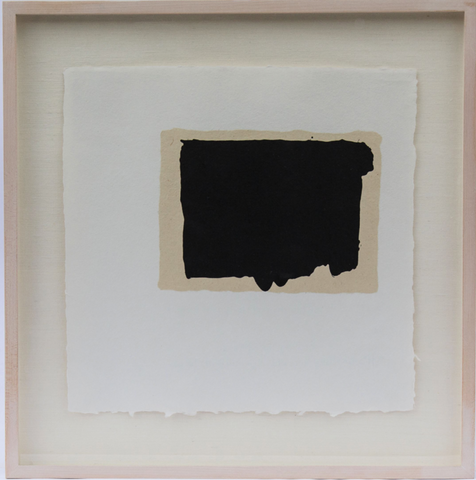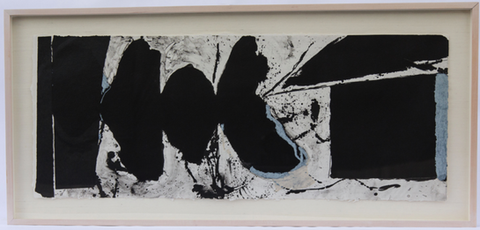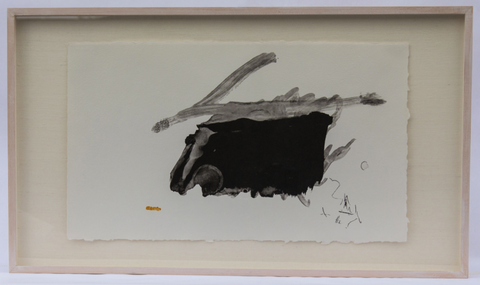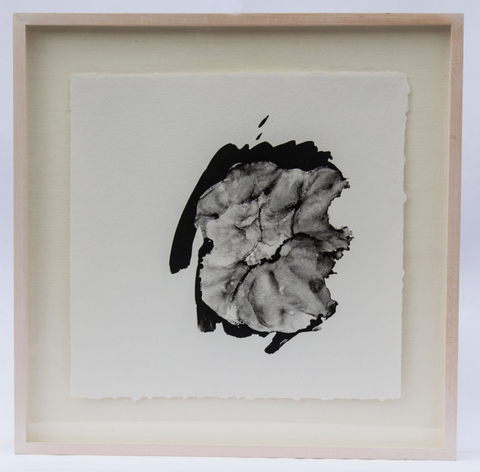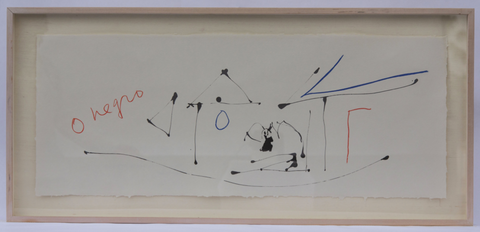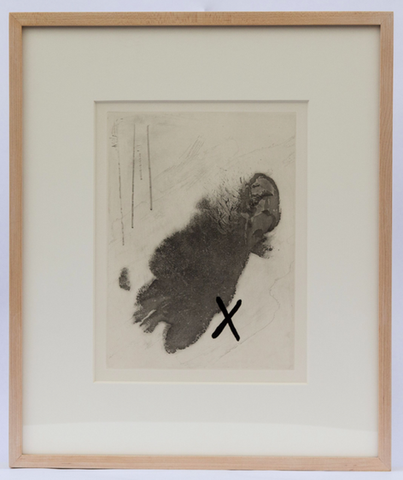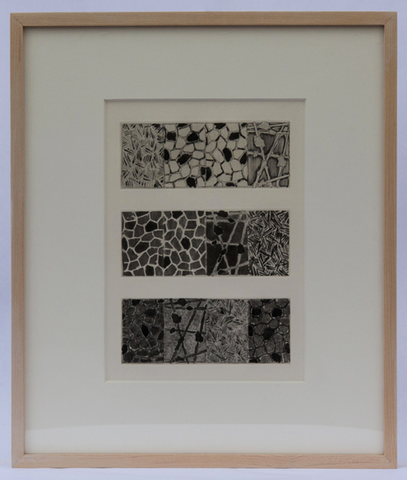JUSTART
METAPHOR AS MANIFESTATION
In 1976 the painter Jasper Johns and poet Samuel Beckett collaborated on the production of Foirades/Fizzles, an illustrated livre de lux consisting of five short essays and thirty-five etchings and aquatints. The collaboration was a highly unusual project for both the artist and the writer. Perhaps equally fascinating was the project on which Robert Motherwell and Rafael Alberti collaborated between 1980 and 1983, which included a short poem dedicated to Motherwell by Alberti, and nineteen lithographs created by Motherwell in response. Though it might be more of a reactionary effort by the painter and the poet than a true collaboration, it was admiration for each other’s work that led to the livre de peintre known as El Negro Motherwell. It was, in fact, not a true collaboration for either project by Johns and Beckett or Motherwell and Alberti — it was a cooperative effort in each case and the result was an exploration of new ground in the creation of artist’s books known as livre d’artiste.
The nineteen lithographs by Robert Motherwell (1915-1991) included in this exhibition are a direct result of the artist’s response to a poem written to Motherwell in 1980 by the Spanish poet and painter Rafael Alberti (1902-1999). Jack Flam, in his preface to the book El Negro Motherwell, published in 1983 by Tyler Graphics, Ltd., states that the body of work evolved as the result of a dialogue between Motherwell and Alberti. According to Flam, “Motherwell chanced upon a copy of Rafael Alberti’s Selected Poems (about 1967) and was especially struck by Alberti’s brilliant and moving cycle of poems in homage to the art of painting…”
In 1972, Motherwell produced a series of etchings based on Rafael Alberti’s poem A la pintura; however, it was not until 1980 that the two actually met, when Motherwell visited Spain to attend the opening of a large retrospective exhibition of his paintings in Madrid. Alberti, who had been an exiled Spanish Loyalist during the nearly forty years of Franco’s reign in Spain, had returned to his homeland to live out the remainder of his life. At the preliminary program preceding the exhibition opening, Alberti came forward and “in an electrifying voice read a poem, El Negro Motherwell, that he had written especially for the occasion.” Motherwell was deeply affected by the experience, and in the months that followed, he worked to produce the series of lithographs included in this exhibition to serve as a fitting response to Alberti’s poem.
Motherwell’s work often evoked themes that related to the Spanish Civil War, and this was no doubt of great interest to Alberti. Flam points out that the two men were able to relate to each other, “united by the intimacy of shared values and shared vision.” Motherwell was, of course, no stranger to writing about painting, and Flam brings to our attention that Alberti was not only a poet but also a painter.
For Motherwell, the moral struggle emitted by the Spanish Civil War provided that basis of one of the central metaphors of his art. The civil war in Spain was seen by many, including Motherwell, as the start of an international struggle against Fascism. For Motherwell, the tragic consequences of the Spanish Civil War became a vehicle for exploring archetypal themes of freedom and loss in his art. Much of his art related to themes of the Spanish Civil War. In 1948, Motherwell painted the first in a series entitled To The Spanish Republic. In fact, the elegy series spanned Motherwell’s entire career, from 1948 to 1991.
In 1976, the American Pop artist Jasper Johns (1930- ) produced his livre d’artiste (artist book), Foirades/Fizzles in collaboration with Samuel Beckett (1906-1989), the Irish-born poet, novelist and playwright who lived in Paris and composed his verses in French. The collaboration between Johns and Beckett was quite unusual insofar as éditions de luxe are concerned. Beckett’s contribution to the project included five short stories while Johns produced thirty black-and-white and three color etchings. Neither Beckett nor Johns had any idea of what the other would contribute to the book, which might define the project as not being a true collaboration in the traditional sense.
The majority of Johns’ images are based on his painting Untitled, 1972, [Museum Ludwig, Cologne] which includes of all of the elements (hatching patterns, flagstones, body parts with casts and slats), used by Johns in creating his etchings. It is not as though Johns’ images sought to illustrate Beckett’s five short stories, but rather to be “the plastic equivalent” of the poet’s verse (as Matisse described his illustrations for his Florilége des Amours de Ronsard). Presented in French as well as English, Beckett’s stories and Johns’ images were conceived independently without knowledge of what the other was planning to contribute.
The brilliance of Foirades/Fizzles lies in the creative qualities of the author and the artist, and the surprising realization that their independent works truly enhance each other’s in creating a rare consonance. Beckett’s verse is ideally suited to Johns’ images and interest. It is the ambiguity that secures the project’s overall success. In one sense it provides endless possibilities for interpretation and, at the same time little or no possibility for complete understanding. It is in fact incomplete as a whole without external influences or awareness of additional knowledge that may be harbored (and possibly only subconsciously) by Johns and Beckett.
The power of Beckett’s poetry stems from one of his central themes — the impossibility of man’s search for self. The following verses are an example:
“…there is nothing but what is said. Beyond what is said there is nothing. What goes on in the arena is not said. Did it need to be known it would be…” And, “…I should have voice, impossible I should have thoughts, and I speak and think, I do the impossible, it is not possible otherwise…”
Beckett’s writing is full of imagery for Johns. And it is not completely unlike some of his own descriptive statements: “Take an object. Do something with it. Do something else with it.” and, “Make something, a kind of object, which as it changes… offers no clue as to what its state or form or nature was at any previous time.” Both statements seem appropriate in gaining some perspective on the understanding of Foirades/Fizzles.
At first it may seem unusual that these two artists should be included in an exhibition that focuses on independent philosophical viewpoints and artistic concerns. Johns, the leader to the generation that “dethroned the Abstract Expressionists,” and Motherwell, one of the leaders and principal exponents of Abstract Expressionism, are being understood, as Beckett writes “…little by little (as) his (own) history takes shape…”
Reilly Rhodes
Curator
Contemporary & Modern Print Exhibitions
This Collection of two leading contemporary American Icons is currently Touring Nationally. They can be viewed at Wolfgang Puck’s Restauarant on El Paseo in Palm Desert, USA. Previous Exhibition sites include Witchita Art Museum, Cornell Museum of Art, Universtiy of Kentucky Museum of Art, Montgomery Museum of the Arts, University of Wyoming Art Museum, Mitchell Gallery/ St. John’s College, Pensacola Museum of Modern Art (2017).
“Poetic works as a metaphor focuses on the collaborative efforts between the artists Robert Motherwell and Jasper Johns and poets Rafael Alberti and Samuel Beckett who shared their creative visions to create a bold, contrasting pairing of visual and literary art forms that aims to fashion an awareness of language while unearthing the complexities of the human mind.” — The Wichita Eagle, Jason Dilts
JASPER JOHNS (American b. 1930), Pop and Conceptual painter and printmaker, helped unseat the Abstract Expressionist movement in the 1960’s. Strongly influenced by Robert Rauschenberg. Considered by many to be the best printmaker in modern times.
ROBERT MOTHERWELL (American 1915-1991), One of the founders and last surviving members of the Abstract Expressionist movement in painting.
